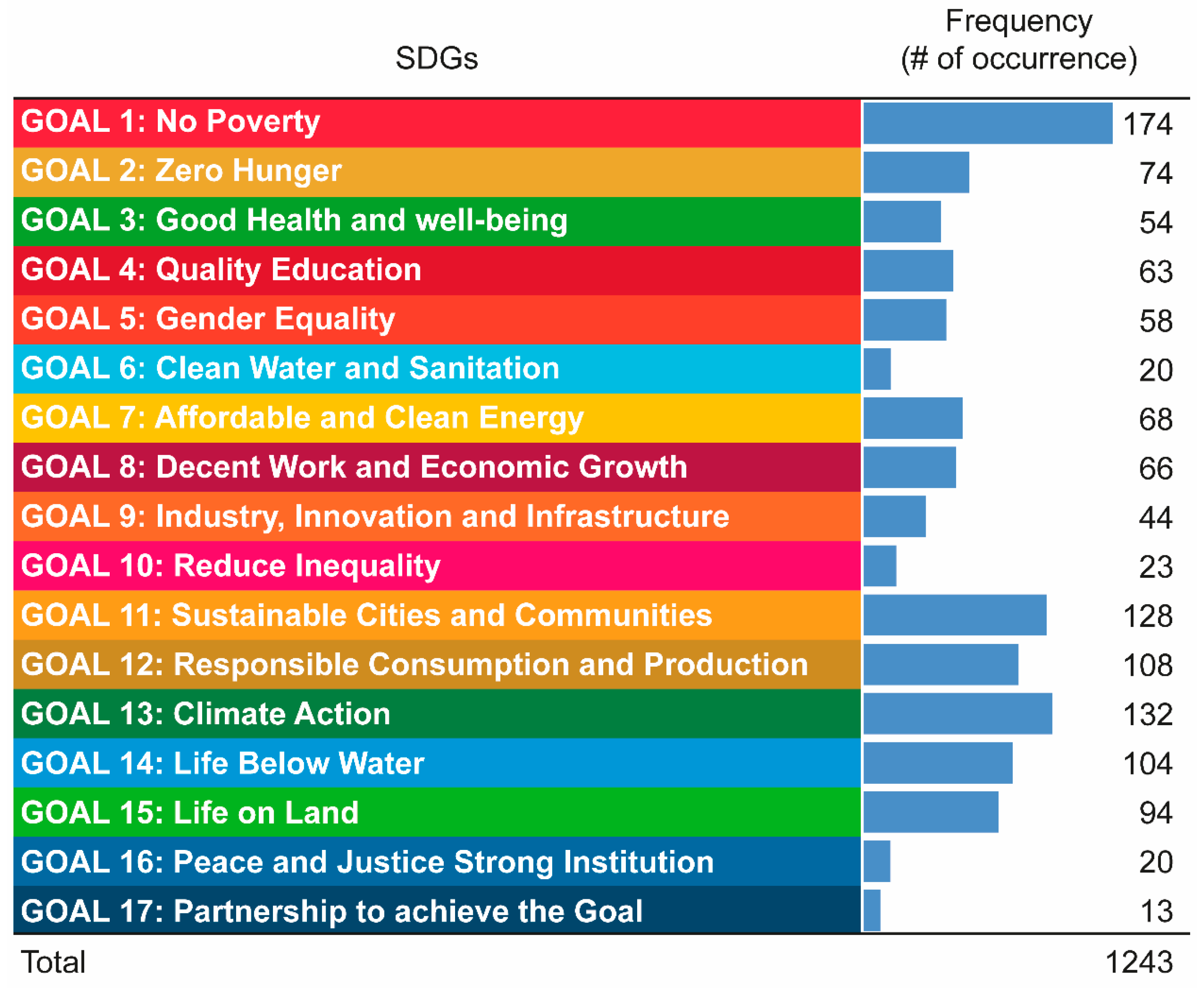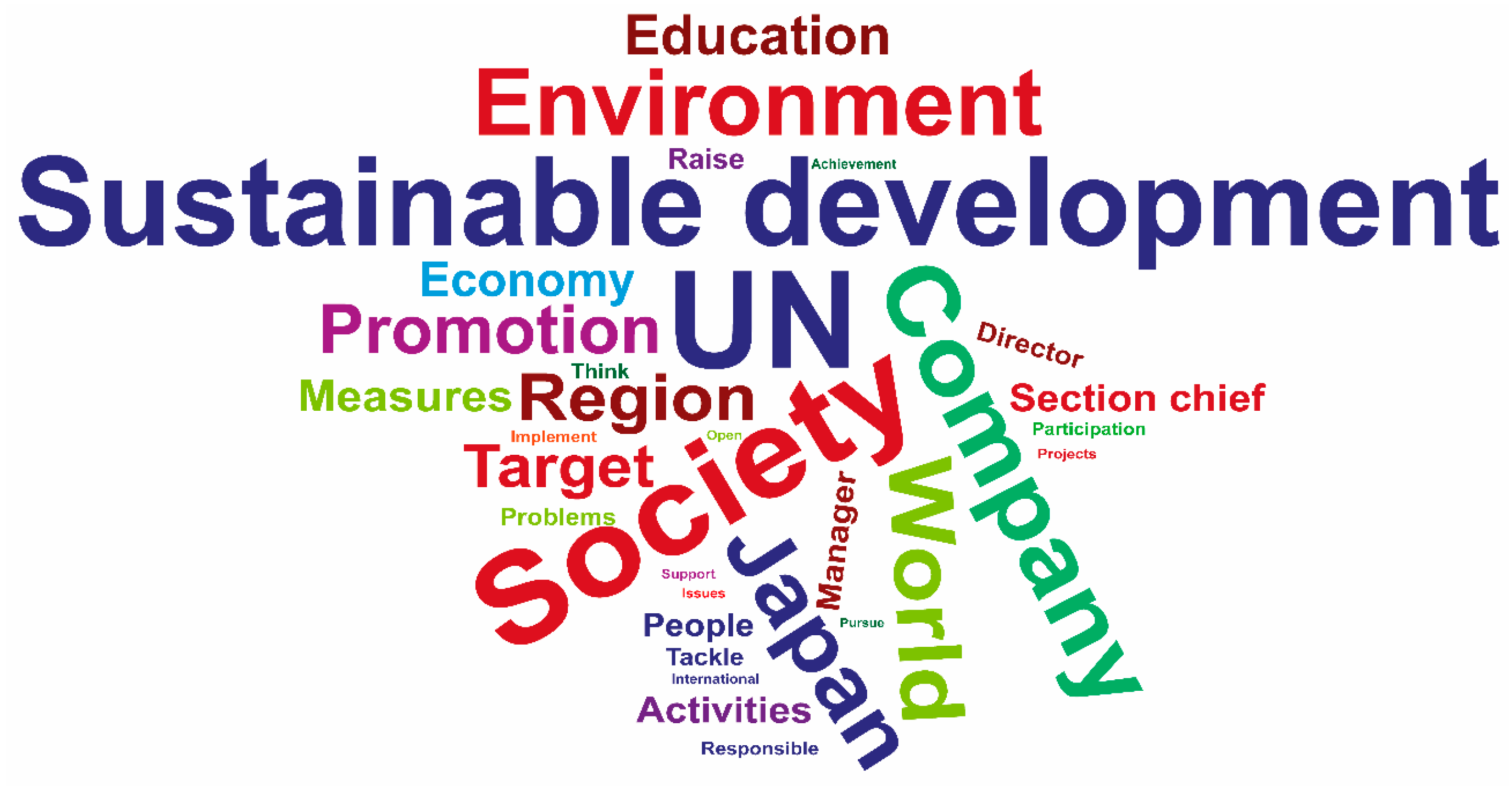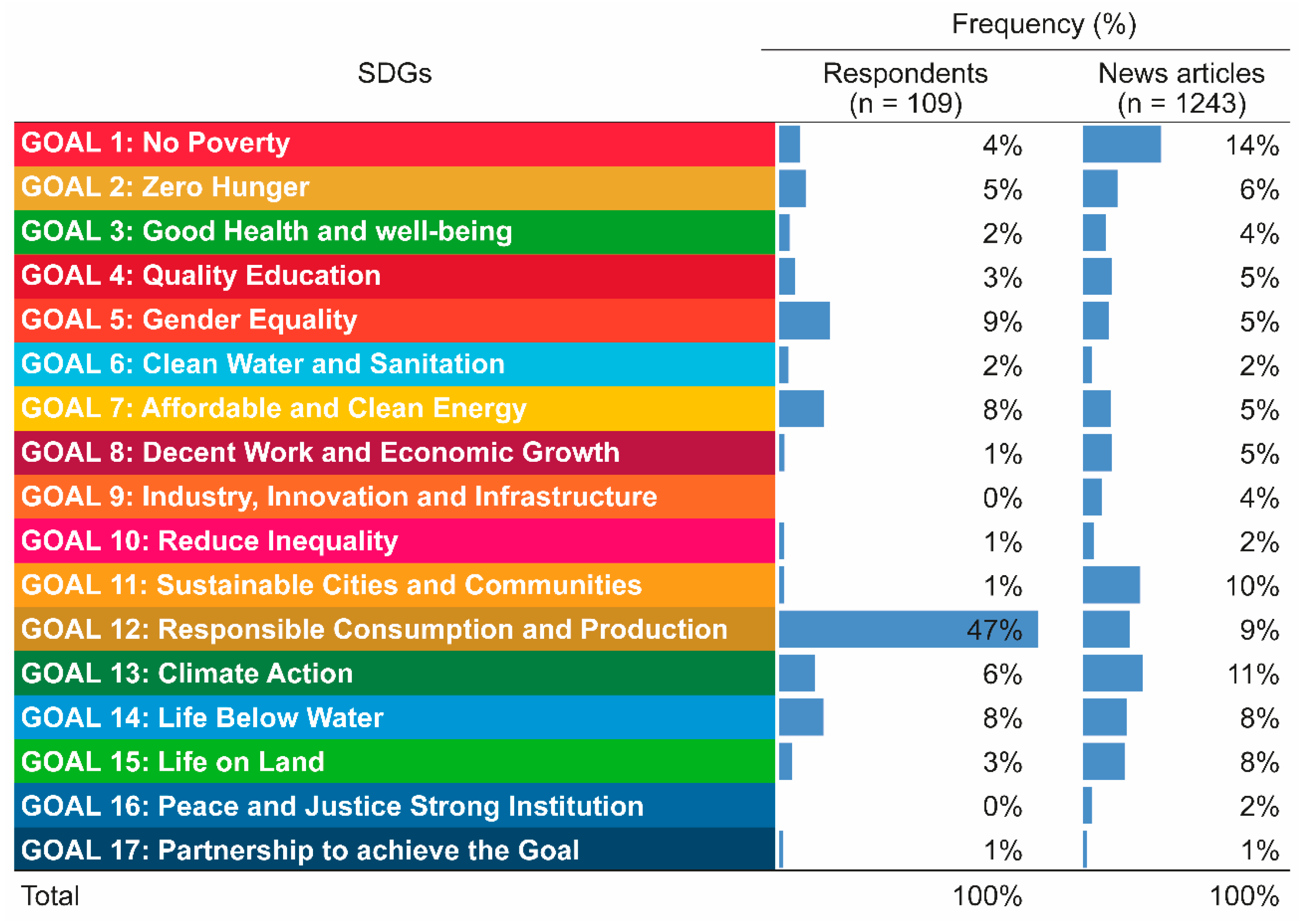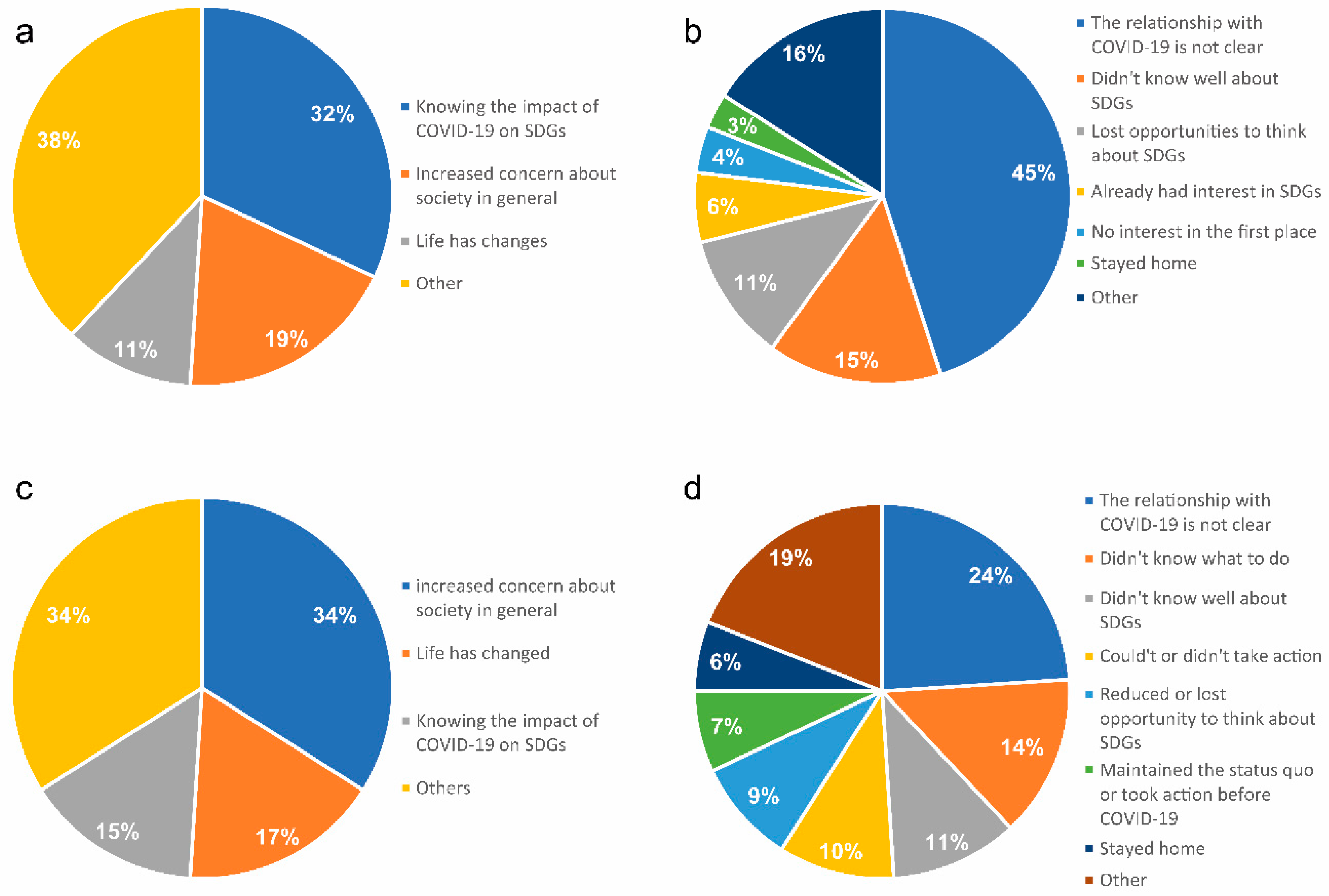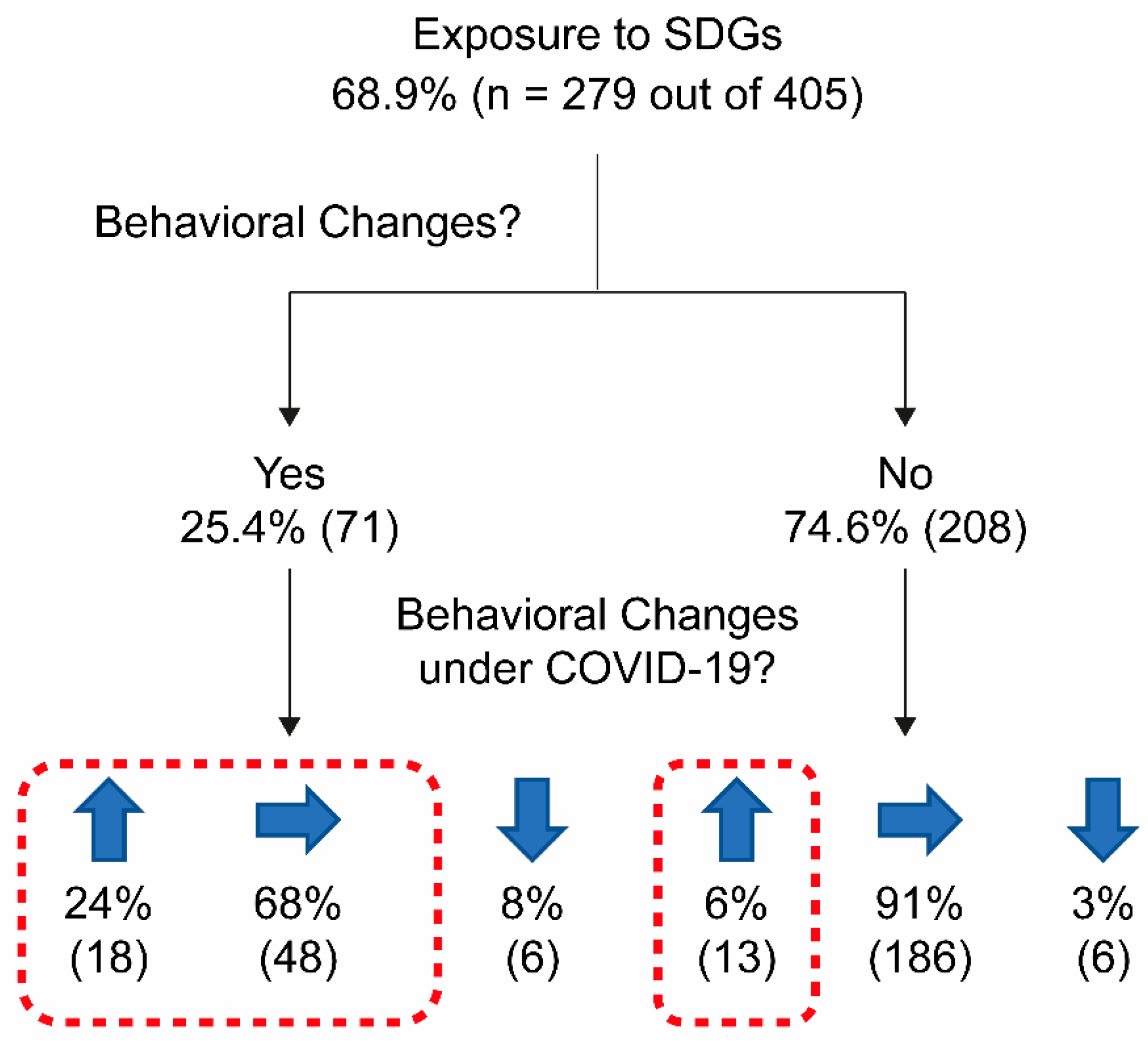1. Introduction
The 17 Sustainable Development Goals (SDGs) adopted by the United Nations (UN) General Assembly in September 2015 are an integral part of the 2030 Agenda for Sustainable Development [
1]. The abbreviation “SDGs” and their logos are ubiquitous in Japan. SDGs are promoted by government entities at the local and national levels, as well as by other entities. Citizens place SDGs logo badges on business suits. Trains wrapped with adverts promoting SDGs are in operation. The mass media covers stories on how we can change our behavior to be consistent with the SDGs. Companies promote their support for SDGs on their websites and with their products. Therefore, we assume that college students in Japan are well-exposed to SDGs. Whether they notice them and change their behavior accordingly must be investigated. For these reasons, we aimed to discover if the SDG term and logos can function as a nudge for steering people’s behavior toward SDGs.
A number of studies have focused on impact assessments of SDGs toward sustainable development. As SDGs comprise goals, targets, and indicators, major studies have assessed the progress toward sustainable development by employing a variety of indicators relevant to the SDGs [
2,
3,
4]. Schmidt-Traub et al. [
5] revealed that their SDG index was correlated with other key indicators for sustainable development, including per capita gross domestic product, the Human Development Index, and subjective well-being. As SDGs essentially embrace trade-offs [
6], some studies combine SDG indicators with other methods to capture the interdependencies [
7]. Other studies link SDGs to sustainable development by employing other methods. Costanza et al. [
8] proposed an approach that combines SDGs with a Sustainable Wellbeing Index (SWI) using a system dynamics model. This approach reflects and synthesizes the non-linear dynamic interdependencies of SDGs and assesses the overall progress of sustainable development using a system dynamics model [
8]. However, to our knowledge, this is the first study to investigate the impact of the SDG term and their logos as a nudge.
A nudge is a term used in behavioral economics to describe a public or private intervention that alters human behavior in particular directions, but allows them to act without forbidding options or significantly changing material incentives [
9,
10,
11]. While nudges are hardly new and are built into the fabric of human society, they are a recent trend in evidence-based policymaking, drawing insights from behavioral economics as a substitute or addition to more coercive approaches, such as command and control regulations [
10,
12,
13,
14]. Nudges play a large role in the United States in multiple areas, including environmental protection [
14]. The Ministry of the Environment of Japan launched the Behavioral Sciences Team to promote nudges [
15]. Nudges have caught the attention of policymakers and researchers for practical and philosophical reasons, rendering them a novel approach. Their benefits are that they often have large effects with low costs and they preserve both human agency and freedom of choice [
9]. In other words, to qualify as a nudge, it must be cost effective and easy to avoid, but not mandatory [
10]. For example, simply adding information to a consumer’s monthly bills contributes to energy savings ranging from 2% to 6% [
16]. In addition, a wide range of actors can nudge from governments to businesses to individuals, in contrast to command and control regulations [
10].
Nudges can take various forms. They can be one of two types according to their purpose: assisting individuals to make choices that are in their own best interest (e.g., saving more for retirement), referred to as “type 1 nudges,” or steering an individual’s behavior to achieve a desired collective end (e.g., encouraging environmentally friendly practices), referred to as “type 2 nudges” [
10]. According to their level of intrusion, nudges can be divided into five types: information dissemination (e.g., government campaigns), governmentally mandated information dissemination (e.g., calorie labels), setting default rules (e.g., defaulting air travelers into the payment of carbon offsets), manipulation (e.g., subliminal advertising), and other mandates [
17]. Nudges may change behavior by helping people counteract a variety of biases and heuristics (rules of thumb) or inform them in the absence of bias (i.e., they may lack information in the first place) [
9,
18]. For example, there may be attempts to counteract a present bias by encouraging people to pay attention to long-term consequences [
9]. Nudges are considered appropriate or needed when decisions “are difficult and rare, for which they do not get prompt feedback, and when they have trouble translating aspects of the situation into terms that they can easily understand” [
11].
SDGs share their characteristics with nudges in four aspects. First, while SDGs are grounded in international law, they are neither legally binding nor intended to grant immediate legal force to the goals [
19,
20]. Therefore, people and organizations can decide how much they contribute toward the goals. In other words, while they are indeed encouraged to contribute to SDGs, people are not directed as to what to do. While our society has not remained on track for all goals, likely due to this non-binding structure [
2,
21], they provide an opportunity to function as a nudge. Second, SDGs involve issues that are highly complex; moreover, it may be difficult to receive prompt feedback for actions. With 17 goals, 169 targets, and 231 indicators proposed, SDGs involve complex interconnections [
8]. Furthermore, we cannot often assume that individual actions aggregate up to system-level sustainability [
22]. In other words, what individuals contribute toward sustainability does not necessarily lead to a sustainable society. As sustainability involves long-term and wide-ranging system change, it takes time to witness improvements caused by our behavioral changes. Third, SDGs can be a type 2 nudge with the level of intrusion of information campaigns steering an individual’s behavior to achieve a desired collective end [
10,
17]. Fourth, contrary to command and control regulations, various actors (government, businesses, and individuals) have promoted SDGs in various forms. The UN Secretary-General called on all sectors of society to take part in this challenge [
1]. For example, a survey revealed that 24.4% of businesses in Japan are implementing or willing to contribute to SDGs [
23]. Some not only implement, but also enlighten their customers. For example, a train company decorated its trains with SDGs as part of an information campaign [
24]. There are media feature articles that propose how the Japanese can contribute to SDGs, along with a reflection on indigenous culture [
25].
The recent outbreak of COVID-19 has led us to pose an additional question: How does the outbreak impact behaviors toward SDGs? Can this be an opportunity to change or is it a risk to achieving SDGs? This may be an opportunity, as claimed by the United Nations: “Leveraging this moment of crisis, when usual policies and social norms have been disrupted, bold steps can steer the world back on track toward the Sustainable Development Goals. This is the time for change, for a profound systemic shift to a more sustainable economy that works for both people and the planet” [
26]. During periods of turmoil, SDGs can be at risk because policies deemed non-essential may be postponed [
27]. Businesses and individuals may also be busy adapting to the current situation, leaving little room to pay attention to SDGs.
The purpose of this study was to assess if SDGs, as a term or logo, have functioned as a nudge or a choice architecture before and during the COVID-19 crisis. While there have been studies examining the use of nudges to achieve SDGs [
28,
29], to our knowledge, this is the first study on how the SDG term or logos nudge people to change their behaviors to contribute to achieving SDGs. As SDGs are a proper noun, i.e., not a common noun, such as “sustainability,” they may be more noticeable to the public. Logos related to SDGs are also often used to promote SDGs. Therefore, they can nudge people, such as the function of eco-labels, although they have not always been successful [
30,
31]. Given its potential impacts on sustainability goals, investigating the impact of COVID-19 is an urgent need; however, few studies have reported on this.
We pose three research questions to assess if the SDG term and its logos function as nudges.
Research question 1: How much have SDGs permeated Japanese society?
Research question 2: By how much do SDGs reach and influence younger generations in Japan via its term and logos?
Research question 3: How has COVID-19 impacted the spread of SDGs and the attitudes of younger generations toward SDGs in Japan?
To answer these questions, we reviewed the news coverage of SDGs in a major newspaper and assessed the attitudes of college students toward SDGs in Japan. Newspapers are a type of major mass media that can reach a broad range of people and reflect on and shape public discourse [
32,
33]. The media stores memories, maps where we are and who we are, and provides materials to guide us into the future [
33]. There are various theories and models for mass media effects, such as the classic stimulus–response model [
33]. While they have traditionally been published in print, most newspapers are now also published on their official websites or provided via portal websites. The younger generation, including college students, are critical in establishing a shift toward a sustainable society. They are mature enough to learn and ready to steer, if they wish, their behavior or career path to be a leader, policy maker, scientist, consumer, researcher, or an entrepreneur who contributes to the attainment of SDGs [
34].
The remainder of this paper is structured as follows.
Section 2 addresses the materials and methods used for the study.
Section 3 reports and discusses the results.
Section 4 concludes this paper.
4. Conclusions
At present, SDGs and their logos appear to be ubiquitous in Japanese society. As they share certain characteristics with the concept of nudges, SDGs can qualify as a nudge. For example, SDGs are not legally binding, involve highly complex issues, and are difficult to receive prompt feedback for actions. This is consistent with the type 2 nudge based on the level of intrusion of information campaigns, steering individuals’ behavior to achieve a desired collective end [
10,
17], and promotion by various actors. To our knowledge, this is the first study to investigate whether SDGs can be qualified as a nudge. This study focused on whether SDGs and their logos steer respondents’ behavior toward achieving SDGs without forcing them to do so.
The content analysis of newspaper articles revealed that the number of articles including SDGs had increased rapidly up to the COVID-19 outbreak, which tempered the spread of SDGs in the newspaper. Permeation was notable given that while there were 734 articles that included SDGs, there were only 25 articles that included MDGs, a predecessor to SDGs. The topic has spread from the general section to others, such as the regional, culture, household, environment, and education sections. Goals were not equally addressed, but were biased toward Goals 1 (no poverty), 11 (sustainable cities and communities), 12 (responsible consumption and production), 13 (climate action), 14 (life below water), and 15 (life on land). The word cloud (
Figure 3) showed that “company” and “region” are often mentioned in these articles. As they appear to have reflected policies and activities implemented in Japan, they can be a proxy for the permeation of SDGs in Japan.
More than half of the respondents, college students, had heard of SDGs or seen the logos, which was higher than surveys in other countries. Although there are no definite criteria for the degree of behavioral changes that can be qualified as a nudge in terms of its efficacy, exposure to SDGs via the terms and logos certainly influenced some respondents’ behavior (25.4%). This indicates that information campaigns to increase the recognition of SDGs can be an effective policy measure. Behavioral changes related to Goal 12 (responsible consumption and production) (47%) were prominent. The relationship between what behaviors students adopted and what was mentioned in the newspapers was not clear, indicating a need for further media analysis including other media (e.g., TV programs and SNS). Contrary to the international survey by Sunstein et al. [
14], trust in organizations was not a predictor for supporting SDGs as a nudge. As Japan was not included in their survey, it would be interesting to perform research directly comparable with their results. Overall, the COVID-19 outbreak served to raise students’ interest and stimulate their behavioral changes. A recent survey in Japan supports this finding; 43% of the respondents (including ages from 18 to 69 years old) answered that the COVID-19 outbreak allowed them to make positive changes regarding their awareness and behavior on environmental issues [
51]. Therefore, this can be a turning point for the government to further promote SDGs as asserted by the UN [
26]. Our study also revealed that perceptions and behavioral intentions significantly changed in the second-round survey in which peers’ opinions were shared. Under unprecedented circumstances, such as the COVID-19 outbreak, sharing peers’ opinions can change young people’s perceptions and behavior. In addition to ESD, sharing peers’ opinions can expedite making the COVID-19 outbreak an opportunity to shift toward a more sustainable society. Hartley et al. [
41] assert the importance of informal peer and group influence for changes to public perceptions.
This study has several limitations. First, Japan may be a unique case, as the recognition of SDGs was higher than other countries [
43]. An international survey exploring the possibility of SDGs as a nudge has not yet be completed. Similar research in other countries would allow us to elicit further understanding of the uniqueness and similarities of how SDGs have permeated different cultures before and during COVID-19. As Sunstein et al. [
14] revealed, there should be cultural differences in how a nudge acts. Second, the survey was conducted with college students in a single college, which is a limitation on the generalization of the findings. Research including a broader sample has yet to be completed. Third, while our content analysis was focused on newspapers, investigating emerging media, such as SNS, and social media, such as Twitter [
52] is as important. While the content analysis of the newspaper articles was meaningful to show how information about SDGs spreads, it may not be sufficient to analyze how the younger generations are influenced by SDGs and their logos, as newspapers were not the primary source of nudging in our study. This indicates that there should be other influential sources worth investigating. Furthermore, investigating multiple media sources together is critical, such as newspapers, magazines, television programs, and emerging media, as well as ESD. Fourth, although respondents indicated good behavioral intentions after their peers’ opinions were shared, there may be a gap between intentions and actual behavioral changes [
53]. Therefore, studies on behavior using, for example, laboratory and field observations, are needed [
54]. Finally, our study did not reveal the cost effectiveness of promoting SDGs (e.g., in terms of the monetary costs or administrative efforts required [
10]). While it is important to investigate this, the evaluation of SDGs does not fit the conventional cost-benefit analysis [
55]. Evaluating the cost-effectiveness of SDGs as a nudge may require an innovative approach in future research.

